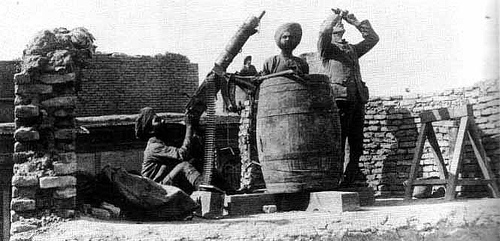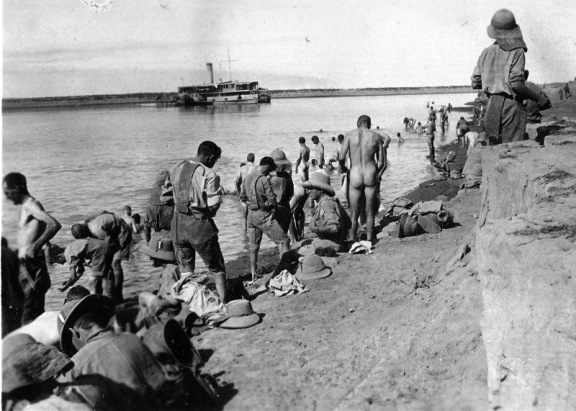British Trapped in Kut; Food and Ammunition Dwindling.
After Seesaw Battle, British Reinforcements Fail to Reach the Town.
Special to The Great War Project
(14-17 January) British troops are under siege at the town of Kut on the Tigris River in Mesopotamia [Iraq].
The Ottoman forces launch their siege on Christmas Eve of 1915. It is now nearly a month old. “Artillery blew great holes in the mud-brick walls of the fortress,” writes historian Eugene Rogan, “as British and Indian troops struggled to repel waves of determined Turkish infantry charging their trenches.”
The casualties are heavy on both sides, reports Rogan, but in this initial stage of the siege of Kut, “the attackers suffered the most.”
“As dawn broke over Kut on Christmas morning, the Turkish dead and wounded lay in piles stretching from the British trenches back to the Ottoman lines. Many of the British survivors wrote of their attempts to assist the Turkish wounded pinned down by the gunfire between enemy lines.”
“In the end,” reports Rogan, “they threw bread and water bottles to those soldiers within range and suffered the groans of the injured until, with time, death brought silence to the terrible battlefield.”
Weeks later many of the Ottoman dead still lay where they had fallen on Christmas Eve.”
As a result of this battle, the Turks make no more effort to storm British positions. The Ottoman forces decide to tighten the noose around Kut, reports Rogan, “cutting Kut off from all supply lines and subjecting the fortified areas to sustained artillery, machine-gun, and sniper fire.”
By mid-January 1916, “the Turkish trenches extended for miles on either side of the river,” writes Rogan. “forcing the British to make frontal attacks over flat ground under heavy and accurate rifle, machine-gun, and artillery fire.”
The British suffer 4,000 casualties at this stage of the battle, even as they seize some of the Ottoman trenches.
The British also take serious casualties on Christmas Eve. And under siege, the prospects of the British look grim. The British commander at Kut General Charles Townshend calculates that as a result of the constant artillery fire, his force of 7,800 troops in late December, will shrink to 5,400 my mid-January, these days a century ago.
At that point, the Turkish force at Kut outnumbers that of the British force defending the town.
Townshend desperately wires his command – the British goal of seizing Baghdad, north of Kut on the Tigris River, is no longer possible. Now he needs reinforcements.
The issue for the British force is how to survive.
The Ottomans continue to attack in the midst of the siege, and the British do manage to claim some local victories. At one point during these days in January, the British reinforcement column and the Turks clash at a tributary of the Tigris known as al-Wadi, south of Kut.
“Fighting in heavy rain and strong winds,” Rogan writes, “the British forces succeeded in driving the Ottomans back.” But the British take serious casualties, losing more than 1,600 men dead or wounded.
Nevertheless the reinforcement column pushes on toward Kut. South of Kut they meet the Turkish forces again at a small town called Hanna. The British commander there “ordered his troops into a frontal assault across open ground on well-entrenched Ottoman positions.”
Reports Rogan, “The attackers slipped and stumbled in the slick of mud left by days of heavy rain, facing intense Turkish gunfire without so much as a shrub for cover. For the first time in the Mesopotamia campaign, the British suffered higher casualties than they were able to inflict.”
“After two days of battle, they had no choice but to give up and retreat” from what a diarist present at the battle called its “hideous memory.”
“I fear it looks as though our relieving force are not strong enough to push through,” he writes, “and are digging themselves in and awaiting reinforcements.”
Now at this stage in the battle for Kut, the reinforcements are awaiting reinforcements.
And the British troops still under siege in the town of Kut see their provisions and ammunition dwindling every day.


